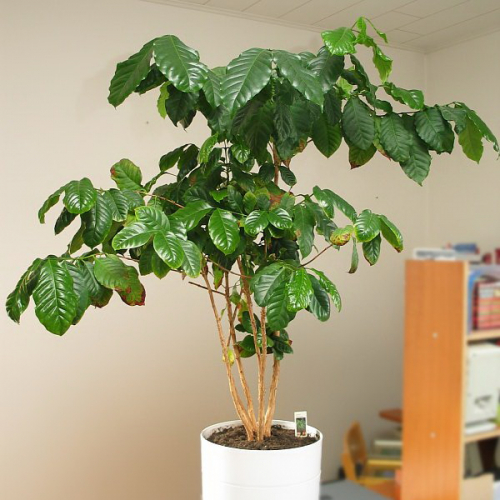Description
Characteristic Features of the Coffea
Coffea is a genus of perennial deciduous and evergreen shrubs and trees assigned to the family Rubiaceae and containing 124 species (without synonyms!). (Russian sources sometimes refer to 40, 50, or close to 60. Wikipedia with over 90 species is the closest to the truth).
In the wild, Coffea is found in several tropical areas of the Old World:
- Mainland Asia (mainly South-East)
- Madagascar and the Mascarene Islands (Mauritius, Réunion) in the Indian Ocean
- Africa (Sierra Leone, Liberia, Cameroon, the Congo basin).
Special mention in this regards should be made to Abyssinia. This is how the current Ethiopia was often called until the end of the 2nd World War. Probably, everyone knows a legend of the local goatherd Kaldi who noticed in the autumn of the year 850 A.D. that his goats, upon eating berries, leaves and branches from a certain plant, became so frisky that they kept him awake all night. The word "coffee" supposedly originated from the Arabic word "gahve" that means "keeping awake". There is another version connecting its origin with the province of Kaffa (Kafa or Kefa) in the Ethiopian Highlands to the south-west of the Abyssinian capital, Addis Ababa (translated from Amharic as "New Flower ").
Properly assessing the value of caffeine, a wonderful tonic substance, in the leaves, bark, and fruit of the tree "keeping awake", people in the 14th century brought the plant from Africa to South Arabia (Yemen) to grow it for profit. Thanks to the tireless ubiquitous traders, it quickly became popular in the Middle East and soon in Europe. In 1753, the Swedish scientist Carl Linnaeus, who was referred to by his contemporaries as "Princeps botanicorum" (first among botanists) recorded the Latin name Coffea arabica in his classification
All attempts of growing this culture in Europe failed. The plant was not hardy enough to overwinter even in the southernmost areas. In early 18th century, coffee was considered a harmful drink that allegedly made women infertile. Later, seedlings of Coffea arabica were brought to Brazil. Currently, this largest Latin American country has 443 billion trees, which account for about 50% of the global plantation area.
There are two species of coffee that rank second after Arabica in their economic importance:
- Coffea canephora, or Robusta
- Coffea liberica, or Liberica.
Three more species are cultivated for the seeds, but with little economic importance, Coffea benghalensis, Coffea excelsa, and Coffea charrieriana.
Coffea Arabica, or a coffee shrub of Arabica, is the only species of the genus Coffea grown as a house plant. This is the only species that can survive in the moderate climate. Coffea Arabica is considered an ornamental foliage plant but it also has attractive:
- five-petal white tubular flowers that grow in delightful axillary clusters of 2-7 and last for 4-5 days
- round cherry-like green berries maturing to reddish brown. Each cherry contains 2-3 hard beans.
The leaves are dark green, smooth, glossy, leathery, either broad 10 centimeters long or oblong ovate centimeters 15 long, with undulating edges.
The flowers are not very small (3 centimeters across), with the fragrance that resembles the smell of jasmine. The first flowers appear after 3-4 years.
The beans of potted Coffea Arabica do not have the unique exciting smell. The plant needs to be grown in a tropical climate for that. In indoor cultivation, the berries ripen slowly, hanging on the plant for 3-4 months, then dry off. You might want to taste them before they dry off. They have a sweetish flavour and are quite edible. A mature coffee tree shrub 1.5 meters tall can produce up to three hundred yellowish gray green beans (about 0.5 kilograms) in a good year.
In the wild, the plant grows to 3-6 (maximum 8) meters tall and branches well. The branches are arranged in opposite pairs and almost horizontal.
Indoors, the plant rarely exceeds 1-3 (maximum 4) meters. The height depends on the variety. There is a dwarf variety ‘Nana' that only grows to 70 centimeters but starts producing fruits in 2-3 years. It forms a bushy shrub almost a meter across. The growth rate is up to 5-10 centimeters per year, mostly in the spring and summer.
There are indoor varieties with unusual colouring of ripe fruits: pale pink, burgundy, yellow, bright red, or dark cherry-coloured.
The Secrets to Successfully Growing Coffea
Coffea needs bright filtered light. In the winter, you will need supplemental lighting, even if you keep it in the southern exposure window; in the summer, shade it from direct sunlight with a gauze or tulle screen (or a spacious hood). You can keep the window wide open or move your plant to a balcony, patio, or in the garden in the summer. Rotate the plant to make sure the shrub is bushy and symmetrical. However, if you change the orientation to the light source, fruit production can deteriorate. Tying a bright strip of cloth to a branch will help to control the position. Coffea can be even taken out to a country house. Place it in the open air in a location protected from rain, wind and especially drafts.
As the plant is native to the tropical areas, make sure to maintain the temperature of 18-22 ° C in the winter. According to various sources, the temperature during the resting period should be maintained at 16-18, 13-17, or even 12-15 C to prevent the leaves from developing black edges, which is a sign of the future death of the plant. The best temperatures in the growing season are 25-30 ° C. Normally warm room temperatures of 22-24 ° C are also suitable for growing Coffea arabica, but the plant will grow slower.
Maintain high air humidity by regular foliar misting (daily in the winter, two or three times a day in the summer) with warm soft or settled water. Water should be lime-free, i.e. contain no calcium (Ca). This environment is difficult to live in both for humans and for the pant. It requires airing without drafts. Besides misting, you might need to:
e the pot in moist expanded clay
2) weekly wash the plant using warm shower (but not in the flowering period!).
However, it is asserted by some super gardeners (probably the lucky ones?) that Coffea tolerates dry air relatively well.
In the winter decrease waterings and air humidity. In the summer, keep the soil moist but not soggy. Allow the top soil to dry out between watering. Prevent the soil from over-drying. Use lime-free water 2-3 ° C warmer than room temperature.
You can prepare the soil mix from:
1) loam (orchid soil), leaf mold, and river sand at 1:2:1
2) loam, leaf mold, humus, and sand at 4:2:1:1 or in equal parts
3) loam, humus, sand, and moss peat at 2:1:2:1 or 1:1:2:1 for young plants
4) loam, sand, and humus at 1:2:1 or at equal parts
5) loam, sand, peat soil at equal parts
6) leaf mold, greenhouse soil, humus, peat, and sand at 1:1:1:2:1
7) humus, sand, and coconut coir at 2:1:1.
The soil should be permeable and most importantly weakly acidic (pH in the range of 5.0-5.5). Adjust pH by gradually adding hardwood ashes (1 half-liter jar of ash per 10 kg of soil). For stabilization, add acetic acid (2-3 drops per 1 liter), citric acid (3-4 crystals), oxalic acid (0.2 grams), or lemon juice (3-4 drops) to the water once per month. The water acidified with such small doses tastes as fresh.
Start feeding the plant in late spring every 10-15 days and stop in the autumn. You might want to apply phosphorus-rich bone meal or horn chips every 10-15 days in April and May bring (1 cup per 10 kilograms of soil). It is said to boost growth and flowering. During the active growing season, mature specimens require a total of at least one liter solution of water with 5 grams of ammonium nitrate NH4NO3 and 3 grams of potassium salt KCl. These basic mineral fertilizers can be alternated with organic fertilizers. For example, you can water the plant with manure slurry or sprinkle chopped dry manure around the tree. Coffea also needs micronutrients, mostly molybdenum (Mo).
Recommendations for repotting:
- The roots are well developed but fragile (brittle), therefore cautiously repot the plant without disturbing the root ball.
- Repot the plant at the end of the resting period in early spring.
- Annually repot the plants younger than 3-4 years old.
- When the plant is older than 3-4 years, repot every other year.
- After reaching maximum pot size, top-dress the plants by adding or replacing the top of potting mixture with fresh one.
- Ensure efficient drainage in the new pot.
Increase bushiness by pinching out young stems, removing dried side shoots, and carefully pruning. Use the cuttings for propagation in the spring.
Cuttings root easily and develop more slowly but better retain features and properties of the mother plant. Propagation from seed is easier, but first, they must be freshly harvested (germination quickly deteriorates) and raw (not roast!), and second, the seedlings begin to bear fruit later.
Potential Problems
Coffea does not live long. At the age of 8-10 years, it loses its decorative effect because branches become weak and bare because of frequent fruiting. To rejuvenate the plant, cut the crown off 8-10 centimeters from the soil surface. When young shoots appear, gradually form a new shrub.
In low light (north-facing window or overshading), the plant slows down or stops growth and fruiting.
Too bright light makes leaves yellow and shrivel. Brown spots (dead tissue areas) indicate sunburn.
Brown spots and slightly curled tips of the leaves result from watering with hard water.
Overwatering or underwatering will cause leaves drop.
The leaf tips turn brown and dry up if air humidity is low. The same happens with lack of feeding.
If the soil pH is 7.0 (neutral reaction) or more (alkaline reaction), the plant will not absorb nutrients from the soil. The leaves get discoloured or covered with dark brown spots with black ends.
Theoretically, caffeine contained in all parts of the plant would have to repel pests. In reality, mealybugs, spider mites, aphids, and scale insects seems to be unaware of it. Prevent infestation with frequent misting and wiping the leaves with soapy water.
Coffea can not grow in close proximity to other indoor plants as it needs space.
* * * *
ATTENTION! Pessimists claim that the beans of domesticated varieties do not have the exciting smell and are generally not suitable for making coffee. This is a mistake, not to say nonsense. The commercially available beans contain much less caffeine than indoor plants.
However, you have to know and thoroughly complete these steps:
1) Remove from the beans from ripe fruits.
2) Soak them in water for 10-12 hours to better clean from mucus.
3) Dry the beans indoors for 10 days.
4) Provide fermentation by drying for 2-3 hours in the oven preheated to 70-80 ° C.
5) After the drying, cool the beans.
6) Fry the beans in the pan constantly stirring until light brown.
7) After roasting, cool the beans. The residual moisture and some of the essential oils should evaporate.
8) Fry again. Eventually, the beans should be dark brown.
Grind the beans, brew and enjoy your coffee!!


